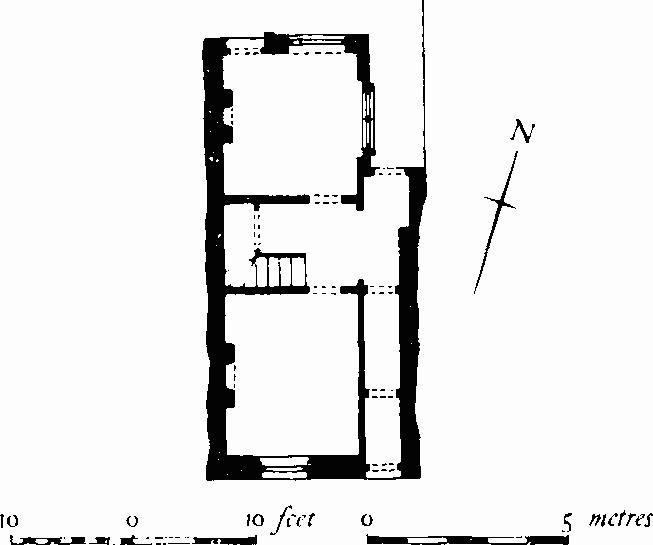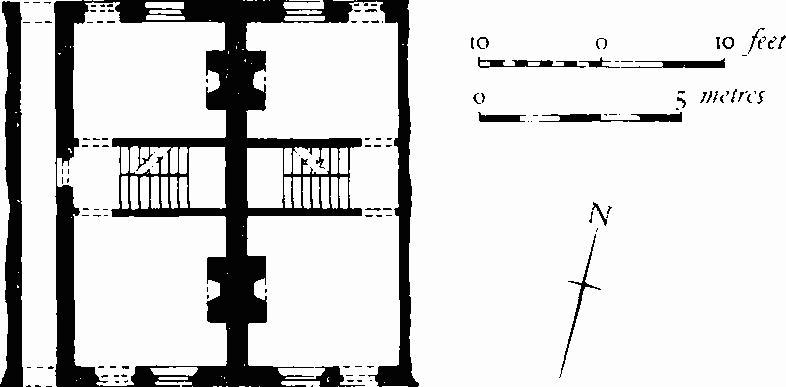An Inventory of the Historical Monuments in the Town of Stamford. Originally published by Her Majesty's Stationery Office, London, 1977.
This free content was digitised by double rekeying. All rights reserved.
'St. Leonard's Street', in An Inventory of the Historical Monuments in the Town of Stamford( London, 1977), British History Online https://prod.british-history.ac.uk/rchme/stamford/pp124-126 [accessed 27 November 2024].
'St. Leonard's Street', in An Inventory of the Historical Monuments in the Town of Stamford( London, 1977), British History Online, accessed November 27, 2024, https://prod.british-history.ac.uk/rchme/stamford/pp124-126.
"St. Leonard's Street". An Inventory of the Historical Monuments in the Town of Stamford. (London, 1977), , British History Online. Web. 27 November 2024. https://prod.british-history.ac.uk/rchme/stamford/pp124-126.
St. Leonard's Street (Fig. 187)
Called Cornstall in the Middle Ages and St. George's Street in the 18th century, this street only acquired its present name in about 1830. The medieval name implies a market function for which there is no other evidence. The street is an early extension of settlement E. of the Danish burh; by the 12th century this had become a parish with a church, St. Michael in Cornstall, on the N. side. The street declined in the late Middle Ages, the church became redundant, and some house sites were vacant by 1570, but by 1650 recovery was taking place and new houses were being built (Blore, 285–90). The long frontages of surviving 17th-century buildings indicate that there was no shortage of land. The extramural part of the street was mainly built in the 19th century, and part of it forms the N. boundary of the Blackfriars Estate laid out in 1840. (See also Blackfriars Estate.)
(314) House, No. 1, on a corner site, three storeys, rubble side wall, ashlar front wall, originally comprised two class 15 dwellings of the early 19th century. The almost symmetrical ashlar elevation on to St. Leonard's Street misleadingly unifies the two dwellings; a large fixed ground-floor window suggests that the corner building, entered from St. George's Street, was designed as a shop.
(315) House, No. 2, three storeys, rubble side walls ashlar front wall, is of class 14b, but the original stair position is unknown. It is early 19th-century; slightly later a stair turret was added at the side. All the openings on the front elevation are plain. Inside, two rooms have moulded plaster cornices; window surrounds have angleroundels.
(316) House, No. 3 (Plate 82), formerly the Olive Branch Inn, two storeys and attics, timber-framed rear wall, ashlar front wall, has a panel on the E. face of the chimney stack inscribed '1666', presumably the construction date. The surviving 17th-century work comprises a single room with a staircase against the back wall. On the front is a three-storey bay window with canted sides, ovolo-moulded mullions and a gable. On the first floor is a late 17th-century bolection-moulded fireplace. At the rear is a long stone range formerly of two storeys and attics; the first floor and attics were united to form an assembly room in the late 19th century. The range was probably built in 1749, the date inscribed on a panel in the E. wall, which also bears the initials 'HWE', presumably those of Henry Wright, upholsterer, who bought the property in 1740 (deeds). He built a row of four class 15 cottages with corner flues beyond the rear wing; they are now in ruins. The inn was extended at the side in the late 19th century.
(317) House, No. 4 (Fig. 159), two storeys, coursed rubble front wall, remainder orange-coloured brick, class 12, was built in 1845 by Moses Peal on the site of a former house (plan in St. George's vestry, survey of property, 1837); the frontage was brought forward 15 ins. to line with its neighbours (Mercury, 9 May 1845). The street front is of two bays with sash windows. Built into the side wall of the rear room is a 17th-century two-light ovolo-moulded window.
(318) House, No. 5, two storeys and cellar, late 19th-century stone walls partly encasing timber-framing, now of class 13b plan, has a 17th-century origin. A gable wall on the E. and the upper part of the rear gable on the N. are timber-framed.
(319) House, Nos. 6–7, two storeys, originally timber-framed, now cased in stone, is probably 16th-century or early 17th-century. In the E. gable a tie beam and rafters are exposed. The plan, of class 8b, and the steeply-pitched roof indicate the early origin of the house. (Inside not seen.)
(320) House, No. 10, timber-framed, two storeys with continuous jetty on the street front, the ground stage under-built in stone, may have a late 16th-century origin. The roof is now slated. The original plan comprised three main rooms (class 8b); the centre room has a later raised ceiling despite the jetty, and an end room has a stop-chamfered axial beam. A tie beam is archbraced to a swell-headed post.

Fig. 158 (321) 15–17 St. Leonard's Street.
(321) Terrace, Nos. 15–17 (Fig. 158; Plate 141), three storeys and cellar, coursed rubble walls; class 14a, early 19th-century. The doorways have rounded heads, and the windows have sashes.
(322) Houses, Nos. 18–19 (Fig. 160; Plate 141), two storeys, cellars and attics, brick walls; class 13a plan, early 19th-century. Doorways and entrance to side passage have round heads.

Fig. 159 (317) 4 St. Leonard's Street.
(323) Reindeer Inn, No. 20 (Plate 141), three storeys at front, two at rear, cellars, coursed rubble walls, is early 19th-century; class 9 plan, with round-headed central doorway and sash windows.
Terrace, Nos. 29–31, see mon. (121)
Houses, Nos. 32 and 33, see mon. (122)
Houses, Nos. 34–38, see mon. (123)
(324) Terrace, Nos. 42–45, two storeys and attics, coursed rubble walls, freestone dressings, consists of four class 15 dwellings; built by William Gregory in the early 19th-century (Ex. MS, 84/10).
(325) Terrace, Nos. 47–52, three storeys and basement, coursed rubble walls, orange brick chimney stacks, comprises six class 15 dwellings of the early 19th century. They are probably the new and substantial houses which Mr. Gregory, builder, was selling in 1835 (Mercury, 20 Mar.). There are no living-room windows in the rear elevation which overlooks a school.

Fig. 160 (322) 18–19 St. Leonard's Street.
(326) Former Carpenter's Arms, No. 54, two storeys and cellar, ashlar front wall, remainder rubble, consists of an 18th-century main range of class 10 plan; a rear wing containing a club room and staircase is described as recently built in 1855 (Mercury, 27 April). The house was probably built by one of the Kidson family of carpenters who lived here from 1702 to 1772; it was a public house by 1801 (deeds). The front elevation was originally of four bays with an asymmetrically placed doorway; the ground floor is now lit by two rectangular bay windows of the early 19th century, and two of the first-floor windows have had their sills raised. The rear wing has a mansard roof and the club room is approached by an external stair on the W.
(327) House, No. 59 (Plate 72), two storeys, now class 10 plan, ashlar front and rubble rear walls, is probably 17th-century; the 18th-century front has a fullwidth bay window with canted sides. This projection, incorporating a central doorway, has a substantial platband at lintel level and narrow platbands at sill level. Scars of a former building survive in the E. gable; the W. party wall is timber-framed. An axial beam has wave stops, and the roof has collars clasping purlins; the interior is otherwise modern.
(328) House, No. 60 (Plate 72), two storeys and attics, now class 10 plan, timber-framed rear wall partly replaced in brick, coursed rubble side walls, has a 17th-century origin as indicated by a hollow-stopped chamfered axial beam. The front wall, entirely of the 18th century, stands forward of the old line as a full-width two-storey bay window with canted sides; the lower part of the wall is of ashlar, the upper of timber-frame. A central door-case has flat hood with shaped brackets. At the rear a stair turret, probably early 19th-century, has coursed rubble walls and hipped roof. Inside are some early 19th-century door architraves with angleroundels.
(329) House, No. 61 (Plate 72), two storeys, class 6, coursed rubble walls, has a panel inscribed '1685', presumably the building date; the panel has diamondpattern border and hood mould. The front elevation has on each floor two windows with large dressed jamb stones, and to the E. a narrow blocked window. To one side is a broad cross passage, open at the ends, from which access to the house is gained.
(330) House, Nos. 62–63 (Plate 72), one storey and attics, stone walls, has a date panel on No. 62 inscribed '1662'. This date relates to the main structure, but the rear wall of No. 62 is medieval and has a stone buttress with mutilated weathered top, and possibly a second buttress to the E.; both wall and buttress were originally higher. The 17th-century front consists of a two-storey bay window with ovolo-moulded mullions, canted sides and a parapeted gable. No. 63 has a two-storey bay window with rendered stone walls, wooden mullions and hipped roof, and an enveloping pentice, all of the 18th or early 19th century.
